Mary Cronk Farrell's Blog, page 10
February 18, 2017
George Washington's Skillful Use of Deception
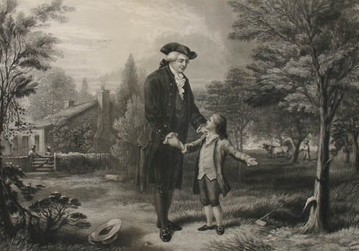
George Washington's famous boyhood confession regarding hatchet and cherry tree was pure fabrication by biographer Mason Locke Weems, but the tale endowed our first president with an inalienable reputation for honesty.
It turns out, George knew when and how to tell a good lie.
"Father, I Can Not Tell a Lie: I Cut the Tree," engraving by John C. McRae, 1867. Without Washington's skill at deception, the ragtag patriots might never have beaten the superior fire and man power of the British.
In the summer of 1780, General Washington and his rebel army faced serious trouble. The deprivations of Valley Forge are legendary, but many historians consider the winter in 1779-1780 to be the most severe of the 18th century.
Washington’s army, shrinking due to desertion and soldiers refusing to reenlist,
camped at Morristown, New Jersey.
 Morristown NJ, Jockey Hollow Cabins, Courtesty Ancestry.com
Morristown NJ, Jockey Hollow Cabins, Courtesty Ancestry.com
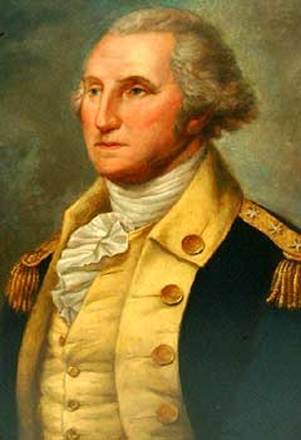 National Park Service Museum Collection With the flowering of spring came the British victory at Charleston, South Carolina. The worst patriot defeat of the war, with the capture of 3000 men and large amounts of munitions and equipment.
National Park Service Museum Collection With the flowering of spring came the British victory at Charleston, South Carolina. The worst patriot defeat of the war, with the capture of 3000 men and large amounts of munitions and equipment.Washington knew a fleet had left France, sailing to his aid, but not when or where the reinforcements would arrive. British General Sir Henry Clinton and his army of 10,000 sat fat and happy in New York City, while the northern patriot army lay scattered in New England.
Lacking muscle and might, Washington turned to mind games and deception.
According to a CIA website, "General Washington was more deeply involved in intelligence operations than any American general-in-chief until Dwight Eisenhower during World War ll."
He concocted a ruse meant to fool General Clinton into believing the French fleet was arriving to help the colonists liberate Canada from the British.
Washington and General Lafayette prepared a document written in French purporting to rally Canadians to the American cause.
"It may indeed be well to throw out an idea that you are to command the corps of American troops destined to cooperate with the French armament," he wrote Lafayette. "The more mystery in this business the better. It will get out and it ought to seem to be against our intention.”
As it turned out, the document was passed to the British by an American commander in Philadelphia--Benedict Arnold, whose traitorous behavior actually did Washington a favor.
More significant was Washington's duplicity a month later when the French fleet landed in Rhode Island.
When he learned through his spy network that General Clinton was quitting New York to engage the French, Washington wrote letters describing plans for a full-fledged attack on New York. Planting documents with known British agents got the word to Clinton, who came sailing back to New York allowing the newly arrived French to rendezvous unhindered with Continental forces.
 Surrender of Lord Cornwallis at Yorktown, John Trumbull, Courtesy North Carolina Museum of Art
Surrender of Lord Cornwallis at Yorktown, John Trumbull, Courtesy North Carolina Museum of ArtThe next year Washington used similar techniques to throw Clinton off and allow the patriots to march south unmolested and lay siege to Yorktown, culminating in the British surrender and freedom for the colonies.
Lucky for us, our first president was not opposed to few untruths for a good cause.
Published on February 18, 2017 09:59
December 3, 2016
Where Sally Got Her Grit
 Coming up next week: Pearl Harbor Day, the surprise attack by the Japanese December 7, 1941, launched America into World War II.
Coming up next week: Pearl Harbor Day, the surprise attack by the Japanese December 7, 1941, launched America into World War II.The American women who resisted the era's preseribed roles for women and served under fire with valor and distinction are sometimes forgotton. If you've read my book Pure Grit you might remember Army Nurse Sally Blaine.
This week I'm featuring photos and anecdotes of Sally that couldn't fit in the book.
Sally had been serving in the Philippines for several months when another nurse woke her to announce Japan had attacked Hawaii. Sally thought it was a practical joke.
But nine hours later, bombs were falling in the Philippines, too. Sally was stationed at Fort Stotsenburg adjacent to Clark Field, home of the largest contingent of the U.S. Air Force in the Far East. “I remember it so vividly. I was tying a shoelace when I heard all those planes going over. I thought they were ours. They bombed terribly and then they came back in little planes and began to strafe the field."
Sally ran to the hospital, where a deluge of wounded overwhelmed the staff and filled every available space in the building. The 45-minute air attack destroyed
fully half of the U.S. Far East Air Force. Within two weeks the Japanese managed a full-scale land invasion.
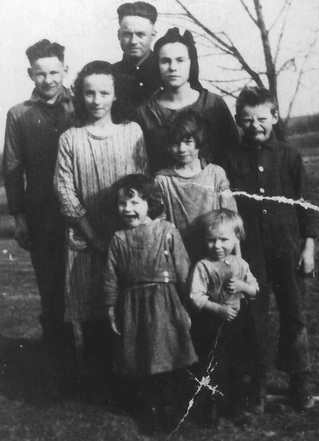 Sally said later, that growing up on the land, in a large family making do with very little, prepared her to survive the war. Sally's the smallest girl in the photo at left, with the big smile.
Sally said later, that growing up on the land, in a large family making do with very little, prepared her to survive the war. Sally's the smallest girl in the photo at left, with the big smile.But escaping farm life in Bible Grove, Missouri, motivated her to join the army. A young man was courting Sally and wanted to marry her. His proposal was that they go follow the crops for three months.
Sally took little time deciding to tell him "no." She went to nursing school, then joined the army. "I had no money, and I knew I would never get to travel unless I went with the military."
Still, she never pictured herself setting up hospital beds in the jungle and nursing the wounded amid flying bullets and exploding bombs. But that's what she did as U.S. troops retreated, the Japanese pushing them into the wilds of the Bataan Peninsula. Below, Sally as a teenager in Bible Grove, Missouri.
 In American war annals, Bataan and Corregidor go down as horrendous defeats. The names are spoken in awe and reverence for the courage and endurance of both the men who survived, and the one-in-three who did not. Until recently, we didn't hear much about the women who were there.
In American war annals, Bataan and Corregidor go down as horrendous defeats. The names are spoken in awe and reverence for the courage and endurance of both the men who survived, and the one-in-three who did not. Until recently, we didn't hear much about the women who were there.A group of nearly one hundred army and navy nurses, including Sally, was the first group of American women ever sent into combat. They were armed only with their nursing skills.
"The medicine we practiced was very primitive," Sally said. We had so few things to make the patients comfortable. There was a machine called a Wagenstein Suction to get fluid from the stomach, which we didn’t have. I improvised one and was so proud of myself.
Below, an Army doctor and patients in a hospital ward in the Bataan jungle.

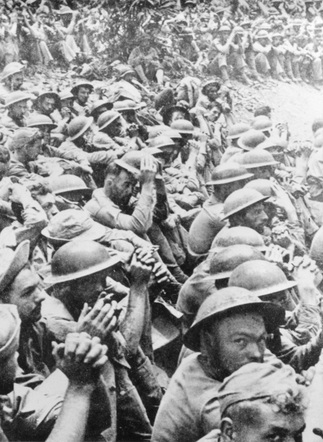 "Fortunately, I was a country girl," Sally said. "So, it wasn’t much of a hardship for me. And most of the nurses on Bataan came from similar backgrounds. We were not prima donnas.
"Fortunately, I was a country girl," Sally said. "So, it wasn’t much of a hardship for me. And most of the nurses on Bataan came from similar backgrounds. We were not prima donnas.We’d take off our dirty clothes and pound the dirt out of them with a rocks and a little soap. We’d throw them on some clean rocks, then bathe and put on our clean clothes.
'We didn’t have much privacy. The first time we went to bathe in the open stream, we were very uneasy. The officers stood 30 yards from us with their pistols unsheathed to protect us. But in a few days we realized we were in no danger from the Japanese. Except for the bombs, of course.
During bombing raids… I’d get in a tent. It didn’t offer any protection, but I didn’t want patients to see me being afraid. How can you show fear in front of your patients? That causes hysteria. I saw a ward become hysterical."
Sally caught malaria, but continued to supervise her ward from a cot.
The last day [before the surrender] I admitted 200 patients and put them on the ground. When I say admitted, I mean a sheet of paper with his name on it. They didn’t get blankets because we didn’t’ have any.
All the American women on Bataan evacuated to nearby Corregidor Island the night before the army surrendered. (At right, American soldiers surrender,
Bataan, P.I., April 9, 1942.)
But things were bleak on the island, too, where nurses worked in an underground hospital tunnel.
As the Japanese barrage of bombs worsened and another surrender seemed inevitable, the army tried to evacuate the American nurses on a submarine and pontoon planes. There was only room for some thirty of the women, and Sally, one of the sickest, suffering continuing bouts of malaria, was chosen.
And here might be the cruelest twist in Sally's story.
She was on her way home, rescued mere days before the surrender of Corregidor, and capture of the remaining 54 army nurses. The two small planes carrying 20 nurses landed on Mindanao Island for refueling, last stop before Australia. One plane took off again, but Sally's seaplane was damaged on take-off, stranding the passengers on an island Japanese forces invaded that very morning.
Within weeks, Sally and the other nurses were seized and eventually sent to the prison camp in Manila where they joined their comrades from Corregidor.
With incredible grit, American nurses survived three years until freed by units of the U.S. First Cavalry Division in early 1945.
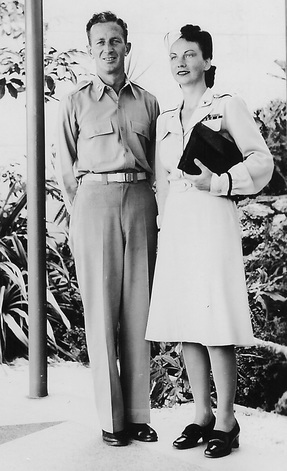 Following the war, Sally married Colonel William Millet, commander of a paratroop regiment at Normandy, who was captured prisoner by the Germans.
Following the war, Sally married Colonel William Millet, commander of a paratroop regiment at Normandy, who was captured prisoner by the Germans.The couple had two sons, Van and Bill, whom Sally raised alone after William died of leukemia. The malaria she contracted on Bataan plagued. Dysentery permanently
damaged her intestinal tract, and dengue fever left her with aching joints and limbs the rest of her life.
But Sally lived, vital, until 91. Her son Van Millet remembers her with great respect and admiration, saying, "She was one tough lady."
Pure Grit has been out nearly three years now, but Sally the the other POW nurses made an indelible impression on me and I think of them often. I continue to reflect on their resiliency and the factors that helped them survive.
Published on December 03, 2016 12:57
October 30, 2016
Three Amazing Women You Did Not Learn About in School
 Sheriff's deputies charge women marching in support of strikers, Trinidad, CO, 1914. In writing about Fannie Sellins, I pulled an unknown heroine out of obscurity to offer today's young women a broader picture of their history.
Sheriff's deputies charge women marching in support of strikers, Trinidad, CO, 1914. In writing about Fannie Sellins, I pulled an unknown heroine out of obscurity to offer today's young women a broader picture of their history.Along the way, I uncovered similar labor union women, whose bravery has likewise been forgotten.
This week, I share some of their stories in honor of the birth day of Fannie Never Flinched, which is Tuesday, in case you missed it!
 Photo courtesy Wayne State University, Eric Margolis In this photo you see the grim faces of strikers outside a union hall in Walsenberg, Colorado after two strikers were shot dead by state police.
Photo courtesy Wayne State University, Eric Margolis In this photo you see the grim faces of strikers outside a union hall in Walsenberg, Colorado after two strikers were shot dead by state police.But you'll never see the face of the woman who took charge of the strike after all the union leaders were arrested.
She's described as a "Mexican mother", a "Indian half breed" and "Mrs. Felix Arrellano" whose husband had been injured in a mine accident.
Though her name is lost to history, The Denver Morning Post recorded her words and deeds, telling how she led a crowd of women storming the jail, demanding to see their husbands and sons who'd been locked up, or transported across the state line under threat of death if they returned.
"If we were asking for diamonds we wouldn't deserve them," this nameless woman began her fiery speech."But we are asking for bread."
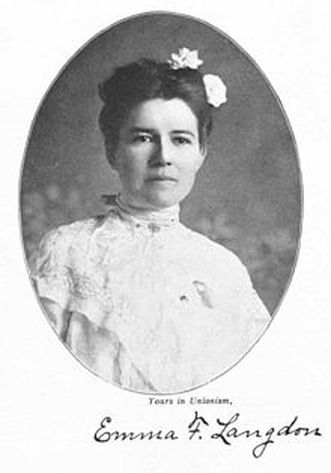 Half a dozen strikers were shot dead and scores wounded before mine owners finally gave in and settled the strike, though they refused to recognize the union.
Half a dozen strikers were shot dead and scores wounded before mine owners finally gave in and settled the strike, though they refused to recognize the union. Another labor union heroine is Emma Langdon, and we know her name because she set linotype at a union newspaper in the gold mining district of Cripple Creek, Colorado.
During the Cripple Creek Strike in 1904, national guard troops arrested the staff of the Victor Daily Record. But they overlooked Emma, maybe because she was a woman.
She sneaked into the newspaper office and working through the night,
published the next morning's edition.
Another brave woman tried to stop the violence of one of the bloodiest attacks in American Labor history.
On Memorial day, 1937, a steelworkers strike turned deadly in southeast Chicago. Police opened fire on a crowd of men, women and children marching toward the front gate of Republic Steel. Ten workers were shot dead and thirty wounded.
Lupe Marshall, a housewife and social worker was one of another fifty-five union sympathizers beaten in the melee of police clubs, tear gas and bullets.
 During and investigation by the U.S. Senate Committee on Education and Labor, Lupe described what happened that day.
During and investigation by the U.S. Senate Committee on Education and Labor, Lupe described what happened that day.I evaded these policemen that were immediately in front of me . . . . I was aware that my head was bleeding. I noticed that my blouse was all stained with blood, and that sort of brought me to, and I started walking slowly toward the direction from which a policeman had just clubbed an individual, and this individual dragged himself a bit and tried to get up, when the policeman clubbed him again. He did that four times.... I screamed at the policeman and said, “Don’t do that. Can’t you see he is terribly injured?” And at the moment I said that, somebody struck me from the back again and knocked me down.
 Memorial Day, 1937, Republic Steel Strike, photo courtesty http://memorialdaymassacre.weebly.com/thesis.html
Memorial Day, 1937, Republic Steel Strike, photo courtesty http://memorialdaymassacre.weebly.com/thesis.html Before Lupe and other victims received medical help, one man died, his head in her lap. As often happened when strikes turned violent, police claimed they acted in self-defense and blamed the violence on communists and radicals.
Some fifteen years later during the McCarthy era, Lupe Marshall was charged with communism and faced deportation under the McCarran-Walter Act of 1952. There is no evidence that she had done anything illegal or was a threat to national security, but she moved to Jamaica and never returned to the U.S.
Published on October 30, 2016 10:48
October 17, 2016
No Sex Scandals, No Political BS--This is a Story about Integrity and Courage!
 Emma in San Antonio jail, courtesy Dolph Briscoe Center for American History Before Cesar Chavez and the grapes boycott there was Emma Tenayuca and the pecan strike.
Emma in San Antonio jail, courtesy Dolph Briscoe Center for American History Before Cesar Chavez and the grapes boycott there was Emma Tenayuca and the pecan strike. Emma was sixteen when she first went to jail, arrested for joining a labor strike by San Antonio cigar workers in 1932.
Emma picked up her social activist ideas at her grandfather's knee, going with him to the La Plaza del Zacate, the center of activity for Mexican American families in West San Antonio. Children could get an ice cream. Jobless families might be hired to pick cotton or work in the beet fields. Stories went round. You could hear the latest news from Mexico read aloud, preaching from the bible and fiery political speeches.
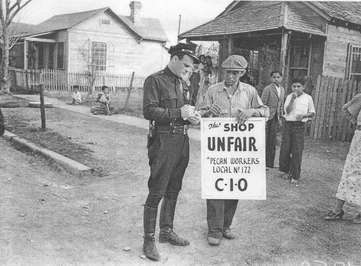 Police cite union picket in pecan workers strike, San Antonio, TX 1938 Seeing police bully picketers during the cigar makers' strike, propelled Emma to keep working for the rights of the poor, a fight that would nearly cost her her life.
Police cite union picket in pecan workers strike, San Antonio, TX 1938 Seeing police bully picketers during the cigar makers' strike, propelled Emma to keep working for the rights of the poor, a fight that would nearly cost her her life.She soon became well-known in San Antonio after leading several marches, demonstrations and sit-ins.
Emma campaigned for a minimum wage, and took up the causes of unfair allotment of New Deal public works jobs, discriminatory removal of Mexican American families from WPA relief roles, and illegal deportations of U. S. citizens of Mexican descent.
"I never thought inWhen some 12,000 pecan shellers walked off the job to protest a wage cut, they converged on a local park shouting "Emma! Emma!" and chose her to lead their strike. She was 21.
terms of fear.
I thought
in terms of justice"
Pecan-shelling was a major industry in the region and one of the lowest-paid in the country. Workers, mostly Hispanic women, typically earned between two and three dollars a week. Work areas were badly ventilated and poorly lit without indoor plumbing.
 San Antonio pecan workers, courtesy http://classicgoldenpecans.com/ San Antonio law enforcement met peaceful picketers swinging clubs, hurling tear gas canisters and making mass arrests. Seven hundred strikers were arrested one day, under orders from the chief of police who stated the strike was a "Red plot" to gain control of the West Side of San Antonio.
San Antonio pecan workers, courtesy http://classicgoldenpecans.com/ San Antonio law enforcement met peaceful picketers swinging clubs, hurling tear gas canisters and making mass arrests. Seven hundred strikers were arrested one day, under orders from the chief of police who stated the strike was a "Red plot" to gain control of the West Side of San Antonio.At that point, the union removed Emma as an official leader of the strike, fearing her ties to the Communist Party would hurt the cause. The strike, one of the largest in the nation, continued for three months until pecan producers agreed to pay the minimum wage set by the Fair Labor Standards Act of 1938.
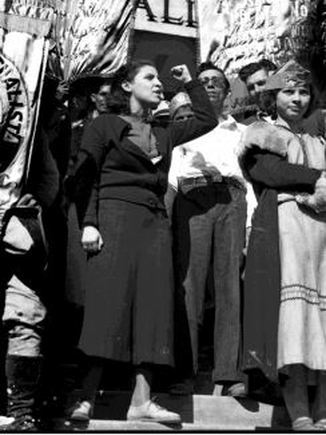 Emma Tenayuca stands on the steps of City Hall, San Antonio, 1938. Courtesy Institute of Texan Cultures Emma Tenayuca was blacklisted for being a communist in the 1930s, and still today, she is not considered a heroine by some people for the same reason. Yet, she was deeply concerned about many of the same issues that trouble us today, the disparity between the rich and the poor, discrimination against people of color and fear of immigrants.
Emma Tenayuca stands on the steps of City Hall, San Antonio, 1938. Courtesy Institute of Texan Cultures Emma Tenayuca was blacklisted for being a communist in the 1930s, and still today, she is not considered a heroine by some people for the same reason. Yet, she was deeply concerned about many of the same issues that trouble us today, the disparity between the rich and the poor, discrimination against people of color and fear of immigrants.Emma courageously went to jail a number of times for her beliefs, saying, "I never thought in terms of fear, I thought in terms of justice."
Some months after the pecan strike settled, Emma planned to speak at a Communist Party meeting at the city's auditorium.
A crowd of 5000 anti-communists gathered to protest and as they stormed the building with bricks and stones, police guided Emma to through a secret underground tunnel.
The rioters, including members of the Ku Klux Klan went on to burn the city mayor in effigy for permitting Emma the right to free speech. Fearing she'd be lynched, Emma left for Houston and later California, unable to return to her hometown for twenty years.
Writer Carmen Tafolla wrote of Emma:
"La Pasionaria, we called her, because she was our passion, because she was our heart -- defendiendo a los pobres, speaking out at a time when neither Mexicans nor women were expected to speak at all."
Published on October 17, 2016 15:09
October 11, 2016
Imagine the Day of Atonement Under Nazi Rule
 The Nazis purposefully chose Jewish holy days for effect when introducing anti-Semitic policies in occupied-Poland. They toyed with people before moving on to genocide.
The Nazis purposefully chose Jewish holy days for effect when introducing anti-Semitic policies in occupied-Poland. They toyed with people before moving on to genocide.
When the Nazi's attacked Warsaw September, 1939, it didn't matter if you were Jewish or Catholic or atheist, everyone worked together for weeks, hoping to hold the city against the Germans.
 Photo courtesy Polish National Digital Archive https://commons.wikimedia.org/w/index...
Photo courtesy Polish National Digital Archive https://commons.wikimedia.org/w/index... The Polish Army understood that Yom Kippur was the most holy day of the year for Jews and excused them that day from the crucial work of digging defensive trenches.
But German bombs had destroyed many synagogues and homes in Jewish neighborhoods so all able males, including children and old men rallied at the city’s barricades, praying the prayers for the Day of Atonement while they worked to protect their city, even as air attacks continued.
From Irena's Children, Young Readers Edition, a year later, Oct. 12, 1940
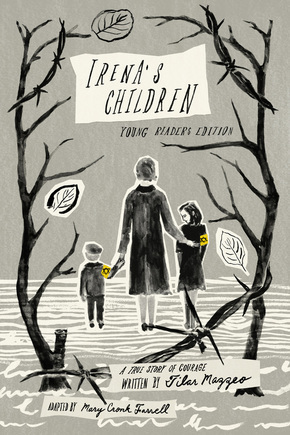 "Already there was tension. The Germans had forbidden all public worship and a number of Jews had decided they would defy the order. As many were rising from sleep, loudspeakers squawked outside their windows. Jewish leaders, the Judenräte, heard the news from city officials, but ordinary people, Irena’s friends, heard it blaring in the street. It was the most sweeping edict yet. Every Jew in Warsaw must move into one small section of the city. They had two weeks. There would be no exceptions."
"Already there was tension. The Germans had forbidden all public worship and a number of Jews had decided they would defy the order. As many were rising from sleep, loudspeakers squawked outside their windows. Jewish leaders, the Judenräte, heard the news from city officials, but ordinary people, Irena’s friends, heard it blaring in the street. It was the most sweeping edict yet. Every Jew in Warsaw must move into one small section of the city. They had two weeks. There would be no exceptions."A long blast of the shofar marked nightfall and the close of Yom Kippur in Warsaw’s Jewish neighborhood. Panic gripped the Jewish community at news of the Nazi’s latest command. The Germans wasted none of their orderly methods on a system to help the nearly one in four Warsaw families ordered to pick up household and move.
Photo below courtesy Library of Congress, European Jew blows Sabbath shofar, circa 1935
 Before the Nazis invaded Poland, 375,000 Jews lived in the capital city, about 30% of Warsaw's total population. As German bombs fell and the Polish Army retreated, refugees flooded to Warsaw pushing the number of Jewish people eventually imprisoned in the ghetto to 450,000.
Before the Nazis invaded Poland, 375,000 Jews lived in the capital city, about 30% of Warsaw's total population. As German bombs fell and the Polish Army retreated, refugees flooded to Warsaw pushing the number of Jewish people eventually imprisoned in the ghetto to 450,000. At the end of the war, only 11,500 Jews had survived. Twenty-five hundred of those were children rescued by Irena Sendler and her underground network. Read that story in Irena's Children.
Published on October 11, 2016 00:00
September 23, 2016
IRENA'S CHILDREN Debuts Next Week! Here's What You Won't See in the Book
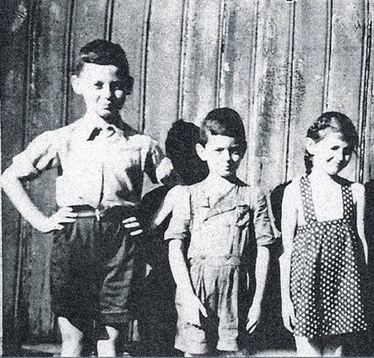 Irena’s Children, Young Readers Edition
[Simon & Schuster] has historical photographs throughout, but many did not make the cut.
Irena’s Children, Young Readers Edition
[Simon & Schuster] has historical photographs throughout, but many did not make the cut.Here's one showing three of the children who's lives Irena saved, Michal Glowinski, Piotrus Zysman, and Elzbieta Koppel.
I don't know when or where the photo was taken. Piotr, in the middle, was four years old when he was sneaked out of the Warsaw Ghetto. I first told Elzbieta's story here. At that time I didn't know I'd later be invited to work on a book about Irena.
The photo below of Irena and an unidentified child is courtesy of the Museum of Polish Jews.
 Courage was rooted deep in Irena's family. During the January Uprising in 1863, which started as a protest by young Poles against conscription into the Imperial Russian Army, Irena's great grandfather's small estate was headquarters for the insurgents near Kalisz in central Poland.
Courage was rooted deep in Irena's family. During the January Uprising in 1863, which started as a protest by young Poles against conscription into the Imperial Russian Army, Irena's great grandfather's small estate was headquarters for the insurgents near Kalisz in central Poland.The Russians put down the Polish-Lithuanian rebels, executed many and deported others to Siberia, including Irena's maternal great grandfather Karol Grzybowski. He died after a year of hard labor manacled to a wheeled cart.
 Irena was greatly influenced by her father, Stanislaw Krzyzanowski's political activities and compassion for the poor, which is detailed in the book. During a typhoid epidemic in their local area, Irena's father was the only doctor who would treat those suffering the illness. He ended up catching the disease himself and dying when Irena was a young child.
Irena was greatly influenced by her father, Stanislaw Krzyzanowski's political activities and compassion for the poor, which is detailed in the book. During a typhoid epidemic in their local area, Irena's father was the only doctor who would treat those suffering the illness. He ended up catching the disease himself and dying when Irena was a young child.Little wonder, Irena would later risk her life posing as a nurse to enter the Jewish Ghetto carrying medicine and food for the sick and starving. (Photograph courtesy of www.chabad.org & The Jewish Women.org)
 Above, Irena Sendler rides in a parade in Warsaw in 1948. (Courtesy Of The Irena Sendler Project) You might think that she would remain a celebrity for her humanitarian deeds, but after World War II when Poland fell to the Communists, Irena was persona non grata like others who had supported or fought for Polish Independence.
Above, Irena Sendler rides in a parade in Warsaw in 1948. (Courtesy Of The Irena Sendler Project) You might think that she would remain a celebrity for her humanitarian deeds, but after World War II when Poland fell to the Communists, Irena was persona non grata like others who had supported or fought for Polish Independence.Irena's Children hits bookstore shelves September 27. Pre-order now to have your book that day!
Published on September 23, 2016 00:00
August 30, 2016
This Guy Didn't Stand by When His Neighbors Were in Trouble
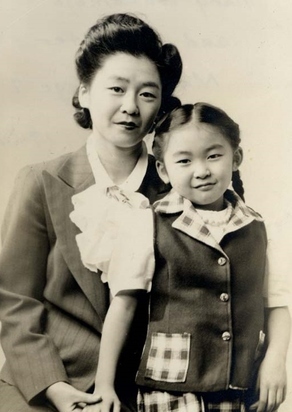 Marielle Tsukamoto was five years old when her family was forced to leave their California farm in 1942 and move across the country to Jerome incarceration camp in Arkansas.
Marielle Tsukamoto was five years old when her family was forced to leave their California farm in 1942 and move across the country to Jerome incarceration camp in Arkansas.Judged a threat to national security by the U.S. and Canadian governments, by neighbors and former friends, most families of Japanese heritage lost their homes and all they owned.
But thanks to one man with moral courage, a sense of justice and a strong work ethic, after the war Marielle and her family were able to come home--home to a running farm, money in the bank and their freshly cleaned house waiting for them.
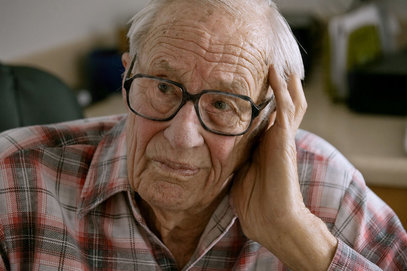 Bob Fletcher in 2010 courtesy Randall Benton/Sacramento Bee In 1942, Bob Fletcher worked as a California fruit inspector in the region southwest of Sacramento where he was known by many of the farmers.
Bob Fletcher in 2010 courtesy Randall Benton/Sacramento Bee In 1942, Bob Fletcher worked as a California fruit inspector in the region southwest of Sacramento where he was known by many of the farmers. As Japanese families packed up to leave for relocation camps, Marielle's father, Al Tsukamoto approached Bob with a proposition.
Would he manage two farms, one owned by an elderly couple while the owners were gone?
If Bob would pay the taxes and mortgages, the offer went, he could keep all the profits.
Bob agreed. He knew little to nothing about the farmers' crops, flame tokay grapes, but he learned. Bob quit his job and committed to run the Tsukamoto farm along with the other two, a total of ninety acres.
This did not make Bob Fletcher popular in town.
 Photo by Dorothea Lange & National Archives Many families sent away to relocation camps could not keep up on their bills and locals had a chance to buy their properties at auction.
Photo by Dorothea Lange & National Archives Many families sent away to relocation camps could not keep up on their bills and locals had a chance to buy their properties at auction.Even before the war Japanese-Americans suffered prejudice. Their children were not allowed to go to school with white children, and sometimes people begrudged their success in business and farming.
Bob Fletcher didn't care what his neighbors thought. He lived in the Tsukamoto's
bunk house and worked farmers' hours, dawn to dusk, for three years.
“Never did agree with the evacuation,” Bob told The Sacramento Bee in 2010. “They were the same as anybody else. It was obvious they had nothing to do with Pearl Harbor.”
“I don’t know about courage...After the war, most Japanese-American farmers came home to nothing, but Marielle remembers arriving to find her family's house just as they had left it, but newly cleaned for their homecoming by Teresa Fletcher, Bob's new wife.
It took a devil of a lot of work.”
Teresa lived in the bunkhouse with her husband, though she had been invited to stay in the house. The Fletcher's used only half of the farms' profits for themselves, leaving money in the bank so the relocated families could make a new start.
As is often true of people who act selflessly, Bob didn't think he was extraordinary. “I don’t know about courage,” he told the Sacramento Bee. “It took a devil of a lot of work.”
How do we cultivate this selfless quality, where we act with generosity, do the right thing, stand up for others being persecuted and it's just all in a day's work?
Let me know what you think!
Published on August 30, 2016 09:38
August 5, 2016
Girls Give Up Olympic Dreams to Boycott Nazis
Just hours from now, hundreds of millions of television viewers will tune in later today for the opening ceremonies of the Olympic games in Rio, a modern global spectacle with historical roots in Nazi Germany.
The Berlin 1936 games were the first ever broadcast on television, and the first to feature the Olympic torch relay from Greece to the site of the games. The torch-lighting was part of Nazi plans to host an Olympics that would out-shine all previous games. Adolf Hitler's propaganda machine was also the first to plan a monumental Olympic stadium. Built of natural stone, with massive budget over-runs, it became the largest coliseum in the world, seating 110,000 spectators.
Adolf Hitler's propaganda machine was also the first to plan a monumental Olympic stadium. Built of natural stone, with massive budget over-runs, it became the largest coliseum in the world, seating 110,000 spectators.
In the month before the dazzling opening ceremonies police arrested nearly one-thousand Roma and Sinti people, interning them in a camp on the edge of the city near Berlin's sewage fields. Organizers in Rio de Janeiro promise a pared-down opening ceremonies due to budget constraints, they have swept their city of "undesirable" street children prior to the onslaught of international tourists, just as the Nazis "cleaned-up" Berlin.
Organizers in Rio de Janeiro promise a pared-down opening ceremonies due to budget constraints, they have swept their city of "undesirable" street children prior to the onslaught of international tourists, just as the Nazis "cleaned-up" Berlin.
In the Copacabana and Maracanã neighborhoods, teenagers and children as young as seven sleep by the roadside and beg for change. Youth advocates say Rio police are detaining children arbitrarily — and in some cases kids are simply vanishing. China's pre-Olympic sprucing-up rid Beijing of beggars, hawkers and prostitutes. See video here...
Few stood up to Nazi propaganda portraying Germany as a tolerant and hospitable nation. The only country to boycott the 1936 games was the Soviet Union. But three young Jewish girls gave up their Olympic dreams to follow their consciences.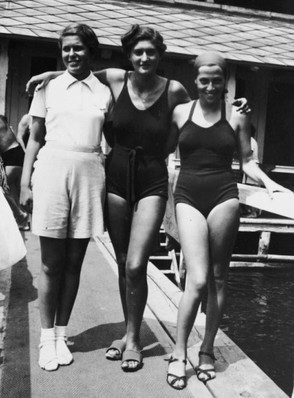 Judith Deutsch, (left in photo) Austria's top swimmer in the mid-1930s, knew of the persecution of Jews in Germany and she experienced much anti-semitism in her home country.
Judith Deutsch, (left in photo) Austria's top swimmer in the mid-1930s, knew of the persecution of Jews in Germany and she experienced much anti-semitism in her home country.
She and two other Austrian swimmers, Ruth Langer (middle in photo) and Lucie Goldman (right) swam at a Jewish club because they were barred from training pools, by signs reading No entry for dogs and Jews.
At age 14, Ruth held eight national titles and the Austrian records in 100m and 400m free-style. Judith
dominated Austrian swimming 1934-36 and was the Austrian National champion in the 100-meter freestyle, 200-meter freestyle, and 400-meter freestyle all three years; she was elected Outstanding Austrian Athlete in 1935.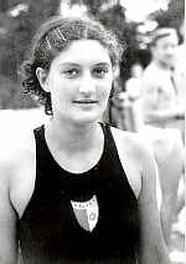 The girls took a stand, stating,
''We do not boycott Olympia, but Berlin."
The girls took a stand, stating,
''We do not boycott Olympia, but Berlin."
In an interview with Reuters, Ruth said, "It was a once-in-a-lifetime opportunity. But being Jewish, it was unthinkable to compete in the Games in Nazi Germany, where my people were being persecuted.''
Because of their refusal to swim in Berlin, Ruth (at right), Judith and Lucie were stripped from the Austrian record books, and suspended by Austrian authorities from all national and international competition. All three girls escaped the Holocaust. Judith (left) emigrated to Israel and became the Israeli National champion and represented Hebrew University at the 1939 World University Games, winning a silver medal.
All three girls escaped the Holocaust. Judith (left) emigrated to Israel and became the Israeli National champion and represented Hebrew University at the 1939 World University Games, winning a silver medal.
Lucie Goldman, the Austrian backstroke champion, escaped to Australia. In 1995, when the Austrian government finally apologized and reinstated the champions’ records, all three women declined to travel to the ceremony.
Judith wrote: "I am happy to accept your apologies and the withdrawal of sanctions against me...And in no way do I regret having done what I did sixty years ago."
When American Jews and Christian and labor groups called for U.S. athletes to boycott the 1936 Olympics, the US Olympic Committee President, Avery Bundage traveled to Germany to investigate claims of Nazi discrimination against Jews. He reported such claims were exaggerated “and the unhindered continuance of the Olympic movement were more important than the German-Jewish situation.” Three Jewish-American track and field athletes withdrew from Olympic trials in protest of Nazi policies.
See the PBS film The Nazi Games here...
The Berlin 1936 games were the first ever broadcast on television, and the first to feature the Olympic torch relay from Greece to the site of the games. The torch-lighting was part of Nazi plans to host an Olympics that would out-shine all previous games.
 Adolf Hitler's propaganda machine was also the first to plan a monumental Olympic stadium. Built of natural stone, with massive budget over-runs, it became the largest coliseum in the world, seating 110,000 spectators.
Adolf Hitler's propaganda machine was also the first to plan a monumental Olympic stadium. Built of natural stone, with massive budget over-runs, it became the largest coliseum in the world, seating 110,000 spectators. In the month before the dazzling opening ceremonies police arrested nearly one-thousand Roma and Sinti people, interning them in a camp on the edge of the city near Berlin's sewage fields.
 Organizers in Rio de Janeiro promise a pared-down opening ceremonies due to budget constraints, they have swept their city of "undesirable" street children prior to the onslaught of international tourists, just as the Nazis "cleaned-up" Berlin.
Organizers in Rio de Janeiro promise a pared-down opening ceremonies due to budget constraints, they have swept their city of "undesirable" street children prior to the onslaught of international tourists, just as the Nazis "cleaned-up" Berlin.In the Copacabana and Maracanã neighborhoods, teenagers and children as young as seven sleep by the roadside and beg for change. Youth advocates say Rio police are detaining children arbitrarily — and in some cases kids are simply vanishing. China's pre-Olympic sprucing-up rid Beijing of beggars, hawkers and prostitutes. See video here...
Few stood up to Nazi propaganda portraying Germany as a tolerant and hospitable nation. The only country to boycott the 1936 games was the Soviet Union. But three young Jewish girls gave up their Olympic dreams to follow their consciences.
 Judith Deutsch, (left in photo) Austria's top swimmer in the mid-1930s, knew of the persecution of Jews in Germany and she experienced much anti-semitism in her home country.
Judith Deutsch, (left in photo) Austria's top swimmer in the mid-1930s, knew of the persecution of Jews in Germany and she experienced much anti-semitism in her home country.She and two other Austrian swimmers, Ruth Langer (middle in photo) and Lucie Goldman (right) swam at a Jewish club because they were barred from training pools, by signs reading No entry for dogs and Jews.
At age 14, Ruth held eight national titles and the Austrian records in 100m and 400m free-style. Judith
dominated Austrian swimming 1934-36 and was the Austrian National champion in the 100-meter freestyle, 200-meter freestyle, and 400-meter freestyle all three years; she was elected Outstanding Austrian Athlete in 1935.
Three young Jewish girls gave up their dreams to follow their consciences.
 The girls took a stand, stating,
''We do not boycott Olympia, but Berlin."
The girls took a stand, stating,
''We do not boycott Olympia, but Berlin."
In an interview with Reuters, Ruth said, "It was a once-in-a-lifetime opportunity. But being Jewish, it was unthinkable to compete in the Games in Nazi Germany, where my people were being persecuted.''
Because of their refusal to swim in Berlin, Ruth (at right), Judith and Lucie were stripped from the Austrian record books, and suspended by Austrian authorities from all national and international competition.
 All three girls escaped the Holocaust. Judith (left) emigrated to Israel and became the Israeli National champion and represented Hebrew University at the 1939 World University Games, winning a silver medal.
All three girls escaped the Holocaust. Judith (left) emigrated to Israel and became the Israeli National champion and represented Hebrew University at the 1939 World University Games, winning a silver medal.Lucie Goldman, the Austrian backstroke champion, escaped to Australia. In 1995, when the Austrian government finally apologized and reinstated the champions’ records, all three women declined to travel to the ceremony.
Judith wrote: "I am happy to accept your apologies and the withdrawal of sanctions against me...And in no way do I regret having done what I did sixty years ago."
When American Jews and Christian and labor groups called for U.S. athletes to boycott the 1936 Olympics, the US Olympic Committee President, Avery Bundage traveled to Germany to investigate claims of Nazi discrimination against Jews. He reported such claims were exaggerated “and the unhindered continuance of the Olympic movement were more important than the German-Jewish situation.” Three Jewish-American track and field athletes withdrew from Olympic trials in protest of Nazi policies.
See the PBS film The Nazi Games here...
Published on August 05, 2016 13:41
July 15, 2016
Small Steps, That's How Peace Happens
I've written a lot about the courage of American World War II nurses, but this week I discovered the heroism of a Canadian nurse, and learned the story of her valiant effort to save a friend after a torpedo attack by the Germans.
I also discovered how taking a step or two out of my comfort zone can generate courage, and I witnessed an amazing step toward peace and reconciliation. It was quite a week after last week's violence combined with my historical photo research. In ten years as a television news reporter I attended scores of demonstrations.
Often when there was a protest, there were protesters protesting the protest.
Never once did I see the two sides come together as I did last week at Spokane, Washington's #BlackLivesMatter rally. But that's what's happening in this photo. Spokane, Washington, Photo courtesy Daniel Wallace McLay An African American pastor asked the crowd to stop reacting to a heckler, then invited the heckler up for a hug. Later, the head of the local NAACP offered the protester the mic and him speak, while the crowd listened respectfully.
Spokane, Washington, Photo courtesy Daniel Wallace McLay An African American pastor asked the crowd to stop reacting to a heckler, then invited the heckler up for a hug. Later, the head of the local NAACP offered the protester the mic and him speak, while the crowd listened respectfully.
Before the end of the rally, those who came to say #BlackLivesMatter, walked to police headquarters and gathered at the memorial for fallen police officers. With a moment of silence and a prayer they demonstrated #BlueLivesMatter, too. Spokane, Washington, courtesy Daniel Wallace McLay The spirit of the rally moved me. I found myself in tears several times as speakers talked of justice, and of healing divisions, of valuing all lives, of ending violence and working toward understanding.
Spokane, Washington, courtesy Daniel Wallace McLay The spirit of the rally moved me. I found myself in tears several times as speakers talked of justice, and of healing divisions, of valuing all lives, of ending violence and working toward understanding.
I came away empowered, empowered not to be silent in the face of trouble, but also, not to be strident and not to be judgmental.
Opportunity immediately presented itself!
But at the rally, I had joined the chant silence is consent to the status quo. And I found myself braver than I ever knew I could be.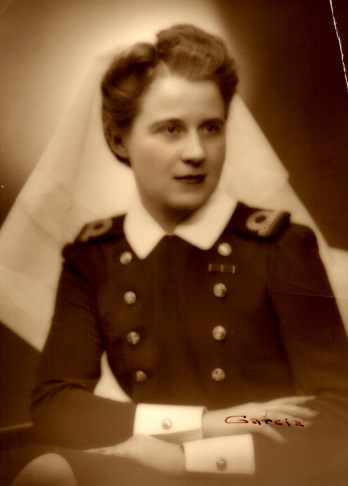 Which brings me to Canadian WWII Nurse Margaret Brooke and the fact that sometimes you can summon your greatest courage and still fail in your task.
Which brings me to Canadian WWII Nurse Margaret Brooke and the fact that sometimes you can summon your greatest courage and still fail in your task.
When the German torpedo slammed against the passenger ferry, the SS Caribou, in the early morning darkness of October 14, 1942, Margaret and Nurse Agnes Wilke were asleep in their bunks.
Margaret and Agnes made it to the deck, but their life boat was gone.
The ship, crossing Cabot Strait off the coast of Newfoundland, sank in just five minutes, taking the women into the water. "We were just busy staying afloat until an overturned lifeboat came along and the people on that helped us," Margaret said later. They grasped ropes, "and we just hung there."
It would be nearly two hours before rescuers arrived, and before then Agnes' strength collapsed. With one arm Margaret clung tight for her survival, and with the other she held onto her friend.
"I held her as long as I could," Margaret says. "I failed. I couldn't hold her any longer." Agnes slipped into the cold depths, one of 137 passengers and crew to die that night.
For her selfless act, Margaret Brooke was named a Member of the Order of the British Empire, and the Royal Canadian Navy has named an offshore patrol boat after her.
Okay, I'm not saying I'm a hero like Margaret Brooke, far from it. What I'm saying is that whether it's a large step or a small one, when we venture from our comfort zone, we risk failure.
And often there's a lot of failure before big change is achieved. But no matter how small, every successful step toward dialogue moves us closer to peace. Small steps also give us hope and strengthen us to take big ones.
I also discovered how taking a step or two out of my comfort zone can generate courage, and I witnessed an amazing step toward peace and reconciliation. It was quite a week after last week's violence combined with my historical photo research. In ten years as a television news reporter I attended scores of demonstrations.
Often when there was a protest, there were protesters protesting the protest.
Never once did I see the two sides come together as I did last week at Spokane, Washington's #BlackLivesMatter rally. But that's what's happening in this photo.
 Spokane, Washington, Photo courtesy Daniel Wallace McLay An African American pastor asked the crowd to stop reacting to a heckler, then invited the heckler up for a hug. Later, the head of the local NAACP offered the protester the mic and him speak, while the crowd listened respectfully.
Spokane, Washington, Photo courtesy Daniel Wallace McLay An African American pastor asked the crowd to stop reacting to a heckler, then invited the heckler up for a hug. Later, the head of the local NAACP offered the protester the mic and him speak, while the crowd listened respectfully.
Before the end of the rally, those who came to say #BlackLivesMatter, walked to police headquarters and gathered at the memorial for fallen police officers. With a moment of silence and a prayer they demonstrated #BlueLivesMatter, too.
 Spokane, Washington, courtesy Daniel Wallace McLay The spirit of the rally moved me. I found myself in tears several times as speakers talked of justice, and of healing divisions, of valuing all lives, of ending violence and working toward understanding.
Spokane, Washington, courtesy Daniel Wallace McLay The spirit of the rally moved me. I found myself in tears several times as speakers talked of justice, and of healing divisions, of valuing all lives, of ending violence and working toward understanding. I came away empowered, empowered not to be silent in the face of trouble, but also, not to be strident and not to be judgmental.
Opportunity immediately presented itself!
Empowered not to be silent in the face of trouble, but also, not to be strident and not to be judgmental.Isn't it funny how that is? This week my personal life offered me the chance to climb down off my high horse, lay down my sword and shield and make the first move toward dialogue. Yes, it was scary. I was afraid I might makes things worse. I was afraid I might get hurt.
But at the rally, I had joined the chant silence is consent to the status quo. And I found myself braver than I ever knew I could be.
 Which brings me to Canadian WWII Nurse Margaret Brooke and the fact that sometimes you can summon your greatest courage and still fail in your task.
Which brings me to Canadian WWII Nurse Margaret Brooke and the fact that sometimes you can summon your greatest courage and still fail in your task. When the German torpedo slammed against the passenger ferry, the SS Caribou, in the early morning darkness of October 14, 1942, Margaret and Nurse Agnes Wilke were asleep in their bunks.
Margaret and Agnes made it to the deck, but their life boat was gone.
The ship, crossing Cabot Strait off the coast of Newfoundland, sank in just five minutes, taking the women into the water. "We were just busy staying afloat until an overturned lifeboat came along and the people on that helped us," Margaret said later. They grasped ropes, "and we just hung there."
It would be nearly two hours before rescuers arrived, and before then Agnes' strength collapsed. With one arm Margaret clung tight for her survival, and with the other she held onto her friend.
"I held her as long as I could," Margaret says. "I failed. I couldn't hold her any longer." Agnes slipped into the cold depths, one of 137 passengers and crew to die that night.
For her selfless act, Margaret Brooke was named a Member of the Order of the British Empire, and the Royal Canadian Navy has named an offshore patrol boat after her.
Okay, I'm not saying I'm a hero like Margaret Brooke, far from it. What I'm saying is that whether it's a large step or a small one, when we venture from our comfort zone, we risk failure.
And often there's a lot of failure before big change is achieved. But no matter how small, every successful step toward dialogue moves us closer to peace. Small steps also give us hope and strengthen us to take big ones.
Published on July 15, 2016 00:00
July 10, 2016
A Week of Killing, A History of Killing...What Can We Do?
I've been doing photo research for my upcoming book about African American women in the 1940's, and the racial prejudice they suffered while serving in the United States Army.
The lynching of blacks was a fact of life for these women, and though it happened mostly in the south, blacks were lynched in northern states, too. I'd been putting off choosing a photo for this part of the story, but finally had to face the images and they left me depressed for days.
Especially after stumbling across a new study that documents the number of lynchings in America is 700 more than previously believed. Titled Lynching in America: Confronting the Legacy of Racial Terror, the report says 3,959 lynchings of African-Americans took place from 1877 to 1950 in states across the South.
 I'll spare you the images, but take a look at this bit of my research.
I'll spare you the images, but take a look at this bit of my research.
An African American in the Women's Army Corp spent a week in the hospital being beaten by a civilian cop for sitting in white waiting room at the bus station in
Elizabethtown, KY.
The cop smashed Private
Helen Smith over the head with a blackjack, dragged her across the bus station floor and threw her in the town jail.
When she was handed over to military police at Fort Knox, she was ordered to face court martial for disorderly conduct and disobeying Kentucky Jim Crow laws. Two other WACs, beaten less severely were similarly charged. The three service women were eventually aquitted when NAACP lawyers argued Kentucky didn't actually have Jim Crow laws written in the books.
The civilian cop faced no repercussions in the case.
The news of two black men killed by police this week and at least four police officers shot to death overnight has added to my very heavy heart.
 Since writing the adaption of IRENA'S CHILDREN last year, I've been much more tuned into Polish history, and the atrocities Poland suffered under the Nazis.
Since writing the adaption of IRENA'S CHILDREN last year, I've been much more tuned into Polish history, and the atrocities Poland suffered under the Nazis.
This week I stumbled across some haunting color photographs taken by Adolf Hitler's personal photographer, Hugo Jaeger, in occupied Poland in 1939 and 1940.
They are heart-breaking, but I looked at each nameless person and envisioned
them beyond the photograph--as flesh and blood, with loved ones, with a life of joys and struggles-- all cut short by the Nazi regime.
See the photos here, in a piece called The Brink of Oblivion. Does remembering the victims move us closer to peace? I don't know. But it's something. Click here to check out an interactive database with information
on police killings in the last eighteen months. There's tons of information, and you can decide for yourself what you think.
Police have a dangerous job. They are often on calls where they fear for their lives.They are human and vulnerable to mistakes when they have to make split-second decisions. Here you can see the honor roll of law enforcement officers killed this year.
Information, talking and listening don't kill anyone. Let's give it a try.
The lynching of blacks was a fact of life for these women, and though it happened mostly in the south, blacks were lynched in northern states, too. I'd been putting off choosing a photo for this part of the story, but finally had to face the images and they left me depressed for days.
Especially after stumbling across a new study that documents the number of lynchings in America is 700 more than previously believed. Titled Lynching in America: Confronting the Legacy of Racial Terror, the report says 3,959 lynchings of African-Americans took place from 1877 to 1950 in states across the South.
 I'll spare you the images, but take a look at this bit of my research.
I'll spare you the images, but take a look at this bit of my research.An African American in the Women's Army Corp spent a week in the hospital being beaten by a civilian cop for sitting in white waiting room at the bus station in
Elizabethtown, KY.
The cop smashed Private
Helen Smith over the head with a blackjack, dragged her across the bus station floor and threw her in the town jail.
When she was handed over to military police at Fort Knox, she was ordered to face court martial for disorderly conduct and disobeying Kentucky Jim Crow laws. Two other WACs, beaten less severely were similarly charged. The three service women were eventually aquitted when NAACP lawyers argued Kentucky didn't actually have Jim Crow laws written in the books.
The civilian cop faced no repercussions in the case.
The news of two black men killed by police this week and at least four police officers shot to death overnight has added to my very heavy heart.
People have very strong feelings on both sides of this issue, but I wish we could create a safe space to talk about violence in America.
 Since writing the adaption of IRENA'S CHILDREN last year, I've been much more tuned into Polish history, and the atrocities Poland suffered under the Nazis.
Since writing the adaption of IRENA'S CHILDREN last year, I've been much more tuned into Polish history, and the atrocities Poland suffered under the Nazis.This week I stumbled across some haunting color photographs taken by Adolf Hitler's personal photographer, Hugo Jaeger, in occupied Poland in 1939 and 1940.
They are heart-breaking, but I looked at each nameless person and envisioned
them beyond the photograph--as flesh and blood, with loved ones, with a life of joys and struggles-- all cut short by the Nazi regime.
See the photos here, in a piece called The Brink of Oblivion. Does remembering the victims move us closer to peace? I don't know. But it's something. Click here to check out an interactive database with information
on police killings in the last eighteen months. There's tons of information, and you can decide for yourself what you think.
Police have a dangerous job. They are often on calls where they fear for their lives.They are human and vulnerable to mistakes when they have to make split-second decisions. Here you can see the honor roll of law enforcement officers killed this year.
Information, talking and listening don't kill anyone. Let's give it a try.
Published on July 10, 2016 00:00



